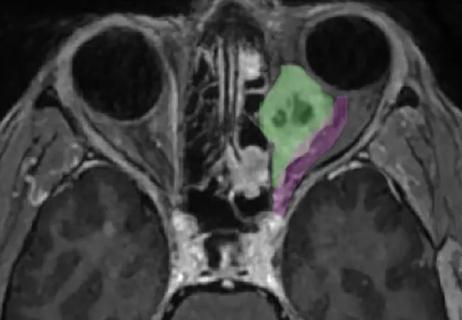Despite advancements in the specialty, patient-centered care needs to remain a priority
Advertisement
Cleveland Clinic is a non-profit academic medical center. Advertising on our site helps support our mission. We do not endorse non-Cleveland Clinic products or services. Policy
As advancements in rhinology and skull base surgery have expanded patient selection and improved surgical planning, treatments have become more precise and more effective. But even as endoscopic techniques and surgical instrumentation have significantly improved the ability to tackle complex cases, Christopher Roxbury, MD, believes it’s even more important to prioritize patient-centered care.
In a recent podcast episode of Head and Neck Innovations, Dr. Roxbury, one of Cleveland Clinic’s newest rhinologists and endoscopic skull base surgeons, discusses the need to understand each patient's individualized perceptions of their symptoms to help tailor their treatment plan accordingly.
“One of the things that drew me to rhinology is the innovation and the development of these endoscopic techniques that we can now employ for patients over the last two decades or so,” says Dr. Roxbury. “…But I think really developing that patient relationship from the beginning and then making sure I'm doing my best to explain what I think's going on to prepare them for the next phases is still of the utmost importance.”
In addition to covering why patient-centered care is so important, the episode also touches on:
Advertisement
Click the podcast player above to listen to the episode now, or read on for a short, edited excerpt. Check out more Head and Neck Innovations episodes at clevelandclinic.org/podcasts/head-and-neck-innovations or wherever you get your podcasts.
Podcast host Paul Bryson, MD, MBA: This seems to dovetail not just in your work here locally but also through the American Rhinologic Society. Can you comment on some of the quality and patient experience improvements that you're working on or that you've found to be valuable to patients?
Christopher Roxbury: So there's a few things. In my own work, I've really gotten interested in healthcare delivery and specifically in the variations in care and in the field of rhinology and skull base surgery in particular. There's a lot of variation in how patients are managed postoperatively. From simple things such as when do we start irrigating patient's noses afterwards, when do we allow them to drive a car, get out on an airplane? And then in terms of how we're taking care of their nasal passages, how often, and when are we debriding them? A debridement is when we clean out the nose and help to remove some of the absorbable packing material that oftentimes goes in after the case.
So we did a study recently looking at that. We said, patients are getting postoperative debridement from either inflammatory sinus disease cases, sinus surgeries that we do or skull base surgeries for tumors.
And we said, well, just anecdotally, there's a lot of variation. When are we doing the debridement? How many are we doing of them? And so we looked at a large database and we were able to sort of say, okay, what's the current state in terms of throughout the U.S. - how many debridement patients are we getting after sinus surgery? And what might be the factors that play a role in that variation?
Advertisement
Of course, our hypothesis was that it really depends on who your surgeon is, where they trained, and what their philosophy is on debridement. And so we were able to do a statistical analysis with a random effects model, which basically helped us to decide where the variation is coming from. We were able to see that about 40% of the variation in how many debridements a patient got after surgery was actually just due to their surgeon.
So basically, that tells us that there's not a whole lot of guidance, so people are kind of doing what they were trained to do, and we need to, as a field, think about how do we maybe make it a little bit more standardized...We're now in the preliminary stages of gathering some data looking at revision surgery rates.
What we were able to actually see is that patients that had one debridement within about 14 days of the surgery actually had about a 7% decrease in their likelihood of having a revision surgery. Opposite side of the spectrum, we saw people who had more than four debridements were at higher risks, so they would have about a 16% higher risk of getting a revision surgery. Now the question with that is, are those patient-related factors? Are those patients who are getting more debridement, are they just not healing as well?So we'll definitely need to do more, perhaps some multicenter studies, to look at that, and from a more granular level see what's going on in those patients that are perhaps getting debrided more.
Dr. Bryson: And what does the revision look like? Is it like a targeted revision in one area after a more extensive functional surgery?
Advertisement
Dr. Roxbury: Exactly.
Dr. Bryson: It's very interesting to try to address it and maybe control for the heterogeneity.
Advertisement
Advertisement

Prompt, multidisciplinary care helps navigate the complexities of a rare condition

Two cases — both tremendously different in their level of complexity — illustrate the core principles of nasal reconstruction

By using free vascularized fascia lata flaps, surgeons can overcome some of the aesthetic and functional challenges historically associated with nasal reconstruction

Novel approach begins reinnervation before tumor resection, preserving a young woman’s smile

Novel collaborative approach helps patient avoid orbital exenteration

Findings suggest new ways to improve outcomes

Case study illustrates the potential of a dual-subspecialist approach

Evidence-based recommendations for balancing cancer control with quality of life